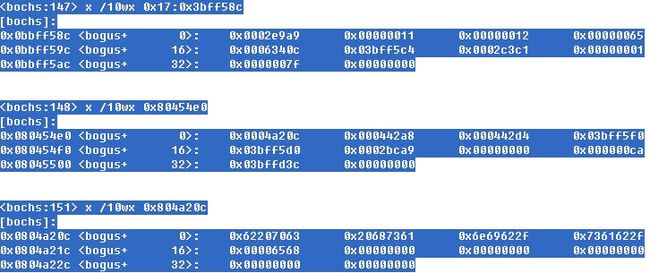linux-0.11调试教程,readline()回显字符调用顺序
{
...
...
if (!rl_done)
rl_redisplay ();
}
因为rl_done为0,所以按下字符键后,会调用rl_redisplay()函数。
update_line()
{
...
move_vert (current_line);
move_cursor_relative (ofd - old, old);
output_some_chars (nfd, lendiff);//这里会调用fwrite()函数!!!
...
}
下面是output_some_chars函数的定义:
/* Write COUNT characters from STRING to the output stream. */
static void
output_some_chars (string, count)
char *string;
int count;
{
fwrite (string, 1, count, out_stream);
}
/* Move the cursor where it should be. */
move_vert (c_pos / screenwidth); //move_vert()移动光标垂直方向位置。
move_cursor_relative (c_pos % screenwidth,
&invisible_line[(c_pos / screenwidth) * screenwidth]);
//move_cursor_relative()函数移动光标位置。
这时光标的位置为0x1e既30
[/root]# cp bash /bin/basheee_
正好是这一行的第29个字符的位置。fflush()函数之后光标会在第30个字符位置显示。
最终fflush()函数之后会显示出字符来。
按下退格键删除一个字符的过程:
如果你按下了backspace退格键
第一步会调用readline_internal()函数中 rl_dispatch (c, keymap);
{ ISFUNC, rl_rubout } /* RUBOUT */
因为这时返回的值是0x7f,对应函数rl_rubout()所以会执行rl_rubout()函数。
switch (map[key].type)
{
case ISFUNC:
{
Function *func = map[key].function;
if (func != (Function *)NULL)
{
/* Special case rl_do_lowercase_version (). */
if (func == rl_do_lowercase_version)
{
rl_dispatch (to_lower (key), map);
return;
}
(*map[key].function)(rl_numeric_arg * rl_arg_sign, key);
第二步会调用rl_rubout ()函数
/* Rubout the character behind point. */
rl_rubout (count)
int count;
{
else
{
int c = the_line[--rl_point];
rl_delete_text (rl_point, rl_point + 1);
...
}
rl_delete_text()处下断点的情形:
第一块内容是堆栈,参数是0x11和0x12。第二块是the_line变量的内容,
第三块是the_line[]数组的内容:cp bash /bin/bashe
下面可以看出rl_delete_text()函数的作用:修改the_line[]数组的内容
rl_rubout (count)
int count;
{
....
if (rl_point == rl_end && isprint (c) && last_c_pos)
{
backspace (1);
putc (' ', out_stream);
backspace (1);
last_c_pos--;
visible_line[last_c_pos] = '\0';
rl_display_fixed++;
}
}
}
也会调用readline_internal()函数中的redisplay()函数,
if (!rl_done)
rl_redisplay ();
然后调用redisplay()函数中的fflush()函数。
但不会调用update_line()函数,move_vert ()和move_cursor_relative ()函数。
readline_echoing_p不为0。



